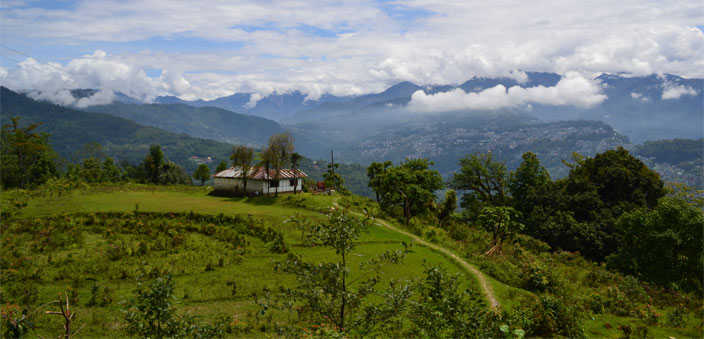As we passed by Chungthang in North Sikkim, we were politely asked to dispose of all plastic bottles at the check-post. The area ahead was free of bottled water- especially Lachen, a remote village at 8,838 feet. The driver, Nishanth from Lachenpa community, informed us rather proudly that his village was one of the first to ban the mineral bottles high up in the mountains.
He added further that Sikkim was fully organic – the only state in our country to have been conferred this title. What’s more, Chief Minister Pawan Chamling was also given the sustainable development leadership award by the President last year. I was suitably impressed. The tiny state of Sikkim in the Eastern Himalayas is giving lessons to the world on sustainability.
Just 7,096 square km with roughly six lakh population, and Sikkim has managed to convert around 75,000 hectares of farm land into organic farms. A slew of measures taken for more than a decade has made the state environmentally sustainable.
This green revolution began in Sikkim as early as 1995. While the year was declared as ‘Harit Kranti year’, the period from 2000-2010 was declared as ‘Harit Kranti decade’ with the intention of increasing the green cover in the state through people’s participation. A lot of initiatives and efforts have gone in to achieve the mission of Green Sikkim. Here are a couple of them.
Banning plastics
The non-recyclable plastics end up in huge numbers in landfills. So that was one of the first things to be banned in the state. Plastic bags and non-biodegradable materials like polythene had been banned way back in 1997. The year 2016 saw the banning of Styrofoam cups, plates, spoons etc., as it was contributing majorly to the landfills – the disposable items were being used in bazaars and in the villages.
Styrofoam cannot be disposed off easily. The burning of Styrofoam releases chemicals like Styrene – a possible carcinogen, carbon monoxide etc., polluting the environment and leading to respiratory problems. So it is best to minimise its usage. The state also managed to ban mineral water bottles from state functions, and instead encourages people to use filtered water in reusable bottles.
Burning of waste banned
While 2014 banned the burning of fire crackers in the state, the following year saw the ban on burning of agricultural waste as well. Agricultural burning is a practice traditionally followed by the farmers. It is a cost effective method –the farm land gets cleared faster after a harvest, the excess waste/vegetation is gotten rid of and often it reduces the incidence of pests in the fields.
Unfortunately, the burning releases carbon dioxide, carbon monoxide and a host of pollutants into the air. This can cause respiratory disorders like wheezing, coughing etc., in the long run. Plus, burning vegetation means there is loss of valuable organic matter addition to the soil. Thus 2016 saw the state banning the burning of agro-waste, leaves, paper waste and litter.
Mission of going organic
The goal of going organic was taken more than a decade back in the state. Chemical fertilisers and pesticides were banned in the state as early as 2002. So farmers had to rely on traditional methods instead – composting, manure etc. With the result that today Sikkim produces 80,000 million of the total 1.24 million tonnes organic yield in the country.
People participation
A lot of programmes have been aimed at making people aware of the importance of greening Sikkim and ensuring their participation. Smriti Van (Memorial forest) is one such beautiful concept. People are encouraged to plant saplings on important events in their life – birthdays, anniversaries, etc. There is a memorial forest at every Panchayat unit. So far, the state boasts around 40 Smriti Van-s.
Another programme called ‘10 Minutes to Earth’ sees people planting saplings on June 25th every year. The time of planting is pre-announced. Free saplings get distributed in forest check-posts for this activity.
In 2006, the ‘State Green Mission’ was launched. The programme was launched to increase green cover in the state by utilising vacant and waste land, along road side and water bodies with the involvement of the public. And the help of NGO, Eco Clubs, and state departments. Saplings of fruit bearing trees, conifers, herbs etc., get planted. In 2013 it completed its eighth year, and from then on it is being celebrated as ‘Paryavaran Mahotsav’ every year for a fortnight.
Schools for environmental awareness
Environmental education is a part of the State’s school curriculum. In 2011, to encourage environmental conservation, Chief Minister’s Green School Rolling Trophy and Green School award were rolled out. Furthermore, Eco Clubs in schools conduct seminars, workshops, tree plantation drives, cleanliness campaigns regularly to sensitise children on environmental issues.
Afforestation initiatives
Numerous initiatives have been done on this front.
Increase in wildlife areas
Sikkim is one of the states that has the maximum area under wildlife protection area. It has one national park, seven wild life sanctuaries, a conservation reserve – all protected areas. Eleven bird areas have been declared in the state. Due to all these efforts, the state has got the ‘Greenest State’ tag with over 47.3% under forest land.
The areas in most of these zones have been declared eco sensitive to conserve and protect wild life. In 2001, Mount Khangchendzonga was banned for mountain expeditions. Also, stringent rules have been formed for trekking bodies. Camping and trekking outside the designated trails is disallowed and is an offence.
This tiny state in the Eastern Himalayas is giving us big lessons on sustainability. Over the years it has bagged many awards in environmental and development sectors. It is time the rest of the country looks up to the state’s efforts and takes a leaf out of it.


 [/column]
[/column]